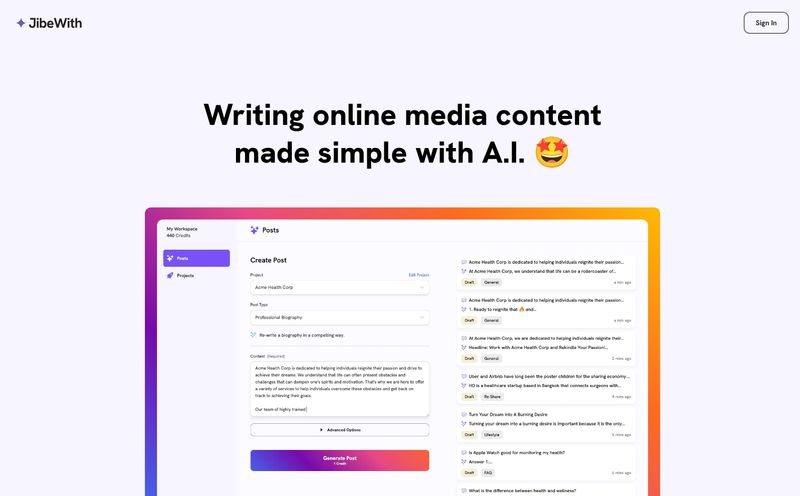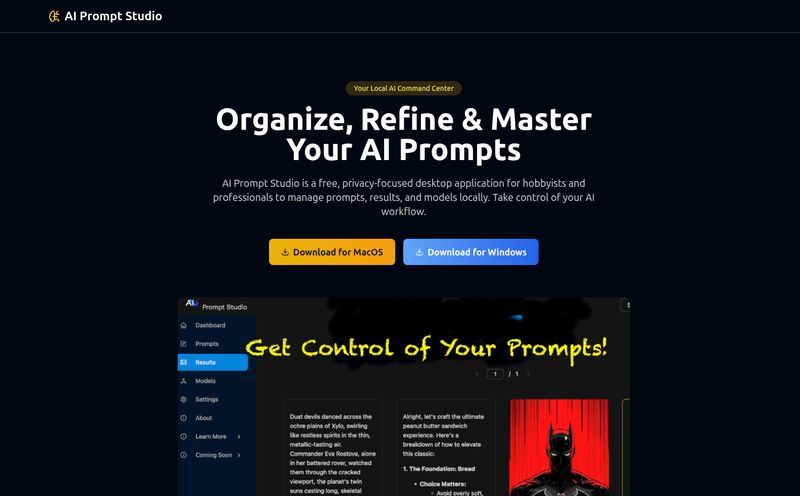Is the Content Treadmill Wearing You Out? This Might Be Your Exit Ramp
If you're in the SEO game, you know the feeling. The constant, gnawing pressure to produce more content. More blog posts, more articles, more… everything. It’s a content treadmill, and some days it feels like the speed is cranked to the max. You’re either spending a fortune on writers or your own sanity is starting to fray at the edges. I've been there, trust me.
For years, we've been looking for that magic button. That one tool to rule them all. And while I’m not a fan of fairy tales, I’ve recently been tinkering with a platform that comes pretty darn close to being a serious game-changer for content workflow. It's called SEO Content Machine, and it’s more than just another AI writer spinning up generic paragraphs.
This thing is designed from the ground up for one purpose: to automate the heavy lifting of SEO content creation and syndication. So, let's pull back the curtain and see if it's all hype or if it can genuinely give you your time back.

Visit SEO Content Machine
So, What Exactly is SEO Content Machine Anyway?
Okay, let's break it down without the corporate jargon. At its heart, SEO Content Machine (or SCM, as its fans call it) is an AI-powered content automation platform. But hold on, don’t roll your eyes just yet. I know “AI-powered” is plastered on everything these days, from toasters to toothbrushes.
What makes SCM different is its focus on RAG (Retrieval-Augmented Generation). Think of it like this: most standard AI models (like the free version of ChatGPT you might play with) have a knowledge cut-off date. They're pulling from a static library of information. RAG is different. It actively pulls in current, relevant information from the web to generate its content. This means the articles it produces are more likely to be accurate, timely, and fact-based, which is a massive win for creating content that Google actually respects.
It's designed to take you from a simple keyword or outline all the way to a fully published, media-rich article on multiple WordPress sites, with very little manual intervention. It's a workhorse, not a show pony.
The Core Features That SEOs and Marketers Will Actually Use
A tool can have a million features, but what really matters are the ones that save you time and make you money. Here's where I think SCM really shines.
Next-Level AI Content with RAG Technology
We touched on RAG, but it’s worth repeating. The ability to generate long-form AI articles that are fact-checked against current data is huge. In my tests, this dramatically reduces the amount of 'AI hallucination' you have to edit out. You can feed it an outline, and it will build out a surprisingly coherent and relevant article. It's not perfect—you’ll still want a human to do a final polish—but it gets you 80-90% of the way there in a fraction of the time.
Automate and Syndicate Your Entire Content Workflow
This, for me, is the crown jewel. SCM isn't just about writing; it's about publishing. You can connect it directly to your WordPress blogs (plural!) and have it automatically post the content it generates. It can even handle things like finding and inserting relevant images and videos, and setting a featured image. Imagine setting up a campaign on Monday to publish five articles across three different blogs over the week, and then just… letting it run. That’s the kind of automation that truly frees up your schedule.
It's a Swiss Army Knife of Content Tools
Beyond the main article generator, SCM is packed with a bunch of other useful utilities. It has a powerful content scraper that can pull data from various sources (think scraping PAA sections from Google SERPs or grabbing content from specific URLs). It can also do bulk rewriting, article translation, and even has a weirdly useful 'About Me' profile generator. It's this collection of smaller tools that turns it from a simple writer into a comprehensive content toolkit.
Let's Talk Money: A Look at the SEO Content Machine Pricing
Alright, the all-important question: what's this going to cost? The pricing structure is actually pretty flexible, which I appreciate. They cater to different commitment levels, from casual users to full-on power agencies.
Here’s a quick breakdown of their main license plans:
| Plan | Price | Billing Cycle | Best For |
|---|---|---|---|
| Trial | Free | 5 Days | Dipping your toes in the water. |
| Monthly | $24 | Monthly | Short-term projects or testing the waters longer. |
| Quarterly | $58 | Every 3 months | Committed users who want a slight discount. |
| Yearly | $120 | Yearly | The best value for long-term users and agencies. |
| Fallback | $198 | One-Time | People who hate subscriptions. Like a lifetime deal. |
That Fallback license is really interesting. You pay a one-time fee of $198, and you get to use the software forever, including one year of updates. After that, you can keep using the version you have, or pay an optional fee (around $80/year, according to their site) to keep getting updates. For anyone who despises recurring subscriptions, this is a fantastic option.
They also have extra, optional AI plans if you burn through your monthly credits, starting at $9/month for a hefty 750,000 extra words. Most people probably wont need this, but it’s there for the power users.
My Honest Take: The Good and The Not-So-Good
No tool is perfect. Let’s get into the nitty-gritty. Based on my experience and the information out there, here's my frank assessment.
What I love is the sheer comprehensiveness of it all. It’s an all-in-one suite that handles the entire content pipeline. The automation is top-notch, and the RAG-powered AI produces genuinely better content than many competitors. And I have to say again, that Fallback pricing option is a breath of fresh air in a SaaS-obsessed world.
However, it's not all sunshine and roses. The biggest drawback for me is that simultaneous logins are not supported. This is a real bummer for agency teams where multiple people might need to jump in. It’s a one-user-at-a-time deal. Also, while it integrates with many AI models, some of the more advanced features might require you to plug in your own paid API keys, which adds a small extra cost. Lastly, a minor quibble: some users have found the pop-up notifications for special offers a bit...enthusiastic. It’s not a deal-breaker, just a small annoyance.
Who is SEO Content Machine Really For?
So, who should actually click that 'buy' button? In my opinion, SCM is a perfect fit for a few specific types of people:
- Solo SEOs and Affiliate Marketers: If you're managing a portfolio of niche sites or affiliate blogs, this tool could be your new best friend. It lets a single person manage the content output of a small team.
- Link Builders and Agencies: For those building out private blog networks (PBNs) or tiered link-building campaigns, the ability to generate and syndicate unique content across dozens of sites automatically is invaluable. (Just, you know, use your powers for good).
- Content Managers on a Budget: If you need to scale content production but don't have the budget to hire an army of writers, SCM provides a cost-effective alternative to get high-quality drafts on the page fast.
It's probably not the right fit for a large enterprise team that needs collaborative features and multiple user seats, or for someone who only publishes one article a month.
Frequently Asked Questions about SEO Content Machine
1. How does the RAG AI actually work?
Think of it as a two-step process. First, the AI 'retrieves' current information from web sources related to your topic. Then, it uses that fresh information to 'generate' the article. This makes the content more factually accurate and up-to-date than AI that only uses its old, baked-in training data.
2. Can I use my own AI models with SCM?
Yes, and this is a pretty cool feature. The website mentions you can connect to LM Studio, which allows you to run various open-source AI models locally on your computer for free. You can also likely connect it to models via API keys, like those from OpenAI.
3. Is the Fallback license really a one-time purchase?
Yes, it is. You pay $198 once and can use that version of the software forever. You get one year of new features and updates included. After the year is up, you can choose to pay an annual fee to continue getting updates, but it's completely optional. Your software will continue to work regardless.
4. What kind of support can I expect?
Based on the testimonials and general consensus online, the support is first-class. The developer seems to be very active and responsive to user questions and feedback, which is a big plus for a tool this powerful.
5. Is it easy to use for a beginner?
There is a learning curve, for sure. It's a powerful tool with a lot of settings to tweak. However, the UI is pretty intuitive, and once you run through the process a few times, it becomes second nature. I'd recommend starting with the 5-day free trial to get a feel for it before committing.
The Final Word on SEO Content Machine
So, is SEO Content Machine the magic button we've all been waiting for? No, because a magic button doesn't exist. SEO still requires strategy, oversight, and a human touch.
But is it a ridiculously powerful engine that can take over 80% of the manual labor involved in content creation and publishing? Absolutely. It’s a force multiplier. It turns one person into a small content team, freeing you up to focus on the things that matter most: keyword research, strategy, and building those all-important links.
If you're a solo operator or a small agency feeling crushed by the content treadmill, I genuinely think SEO Content Machine is worth a serious look. Grab the free trial, kick the tires, and see if it can be the workhorse your business needs. You might be pleasantly surprised.
References and Sources
- SEO Content Machine Official Website
- Official Plans and Pricing Page
- Moz's Beginner's Guide to Content Marketing



